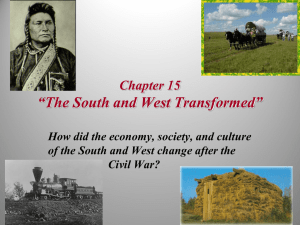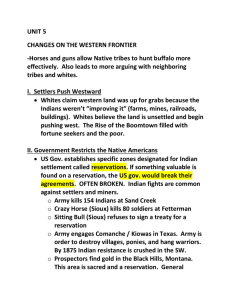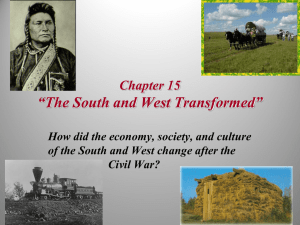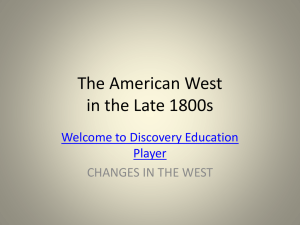Unit 5
advertisement
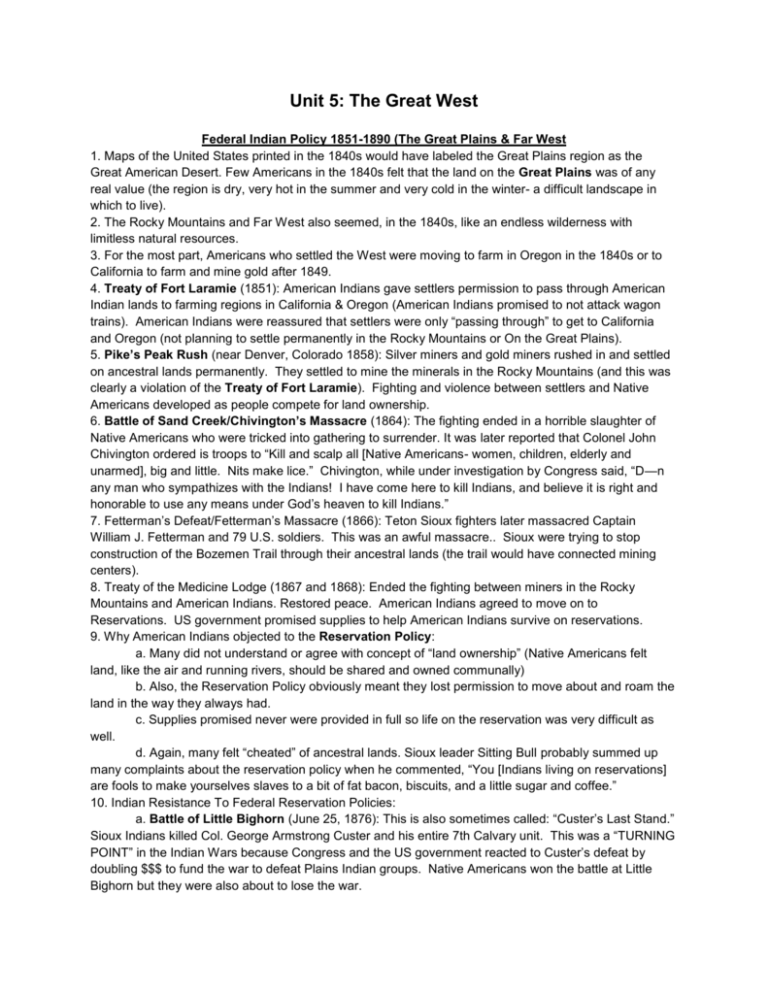
Unit 5: The Great West Federal Indian Policy 1851-1890 (The Great Plains & Far West 1. Maps of the United States printed in the 1840s would have labeled the Great Plains region as the Great American Desert. Few Americans in the 1840s felt that the land on the Great Plains was of any real value (the region is dry, very hot in the summer and very cold in the winter- a difficult landscape in which to live). 2. The Rocky Mountains and Far West also seemed, in the 1840s, like an endless wilderness with limitless natural resources. 3. For the most part, Americans who settled the West were moving to farm in Oregon in the 1840s or to California to farm and mine gold after 1849. 4. Treaty of Fort Laramie (1851): American Indians gave settlers permission to pass through American Indian lands to farming regions in California & Oregon (American Indians promised to not attack wagon trains). American Indians were reassured that settlers were only “passing through” to get to California and Oregon (not planning to settle permanently in the Rocky Mountains or On the Great Plains). 5. Pike’s Peak Rush (near Denver, Colorado 1858): Silver miners and gold miners rushed in and settled on ancestral lands permanently. They settled to mine the minerals in the Rocky Mountains (and this was clearly a violation of the Treaty of Fort Laramie). Fighting and violence between settlers and Native Americans developed as people compete for land ownership. 6. Battle of Sand Creek/Chivington’s Massacre (1864): The fighting ended in a horrible slaughter of Native Americans who were tricked into gathering to surrender. It was later reported that Colonel John Chivington ordered is troops to “Kill and scalp all [Native Americans- women, children, elderly and unarmed], big and little. Nits make lice.” Chivington, while under investigation by Congress said, “D—n any man who sympathizes with the Indians! I have come here to kill Indians, and believe it is right and honorable to use any means under God’s heaven to kill Indians.” 7. Fetterman’s Defeat/Fetterman’s Massacre (1866): Teton Sioux fighters later massacred Captain William J. Fetterman and 79 U.S. soldiers. This was an awful massacre.. Sioux were trying to stop construction of the Bozemen Trail through their ancestral lands (the trail would have connected mining centers). 8. Treaty of the Medicine Lodge (1867 and 1868): Ended the fighting between miners in the Rocky Mountains and American Indians. Restored peace. American Indians agreed to move on to Reservations. US government promised supplies to help American Indians survive on reservations. 9. Why American Indians objected to the Reservation Policy: a. Many did not understand or agree with concept of “land ownership” (Native Americans felt land, like the air and running rivers, should be shared and owned communally) b. Also, the Reservation Policy obviously meant they lost permission to move about and roam the land in the way they always had. c. Supplies promised never were provided in full so life on the reservation was very difficult as well. d. Again, many felt “cheated” of ancestral lands. Sioux leader Sitting Bull probably summed up many complaints about the reservation policy when he commented, “You [Indians living on reservations] are fools to make yourselves slaves to a bit of fat bacon, biscuits, and a little sugar and coffee.” 10. Indian Resistance To Federal Reservation Policies: a. Battle of Little Bighorn (June 25, 1876): This is also sometimes called: “Custer’s Last Stand.” Sioux Indians killed Col. George Armstrong Custer and his entire 7th Calvary unit. This was a “TURNING POINT” in the Indian Wars because Congress and the US government reacted to Custer’s defeat by doubling $$$ to fund the war to defeat Plains Indian groups. Native Americans won the battle at Little Bighorn but they were also about to lose the war. b. Chief Joseph’s March (Nez Perce Indians of Idaho 1877): Joseph tried to escape the reservation and marched nearly a thousand miles while being chased by federal troops who wanted to arrest him and his followers for leaving the reservation. Sadly for him, he was captured just below Canadian Border. He commented when captured, “I am tired of fighting. Our chiefs are killed… It is cold and we have no blankets. The little children are freezing to death. My heart is sick and sad. I WILL FIGHT NO MORE FOREVER.” c. Geronimo (Apache in SW USA 1881-1886): This Apache leader also became famous for trying to escape the reservation. He also was captured in the end. 11. U.S. Response to Indian Resistance To Government Reservation Policies: a. People were angry at the American Indians for wiping out Custer at the Battle of Little Bighorn. Public opinion supported a stronger military campaign to force the Plains Indians to submit. The New York Herald newspaper observed, “it is inconsistent with our civilization and with common sense to allow the Indian to roam over a country as fine as that around the Black Hills, preventing its development in order that me may shoot game and scalp his neighbors. That never can be. This region must be taken from the Indian.” b. Buffalo (20 million animals in 1860, 900 in 1890) Nearly hunted into extinction. Once provided Plains Indians with many essential things in life. Killing the buffalo also even became a military tactic the government used to force American Indians onto reservations (many Native Americans, without their traditional food source became desperate and more willing to live on reservations). c. Helen Hunt Jackson (1881): Wrote A CENTURY OF DISHONOR- a book describing how American Indians were abused. She wrote, “It makes little difference where one opens the record of the history of the Indians; every page and every year has its same dark stain [where the government broke treaties and took their land].” This book motivated many Americans to find a way to help Native Americans. d. Assimilation Programs to “Americanize” the Plains Indians (these programs were supposed to help American Indians but usually did more harm than good) i. Carlisle Indian School (Pennsylvania 1879): A boarding school/orphanage. American Indians were forced to assimilate or adopt “white” culture ii. Dawes Servility Act (also called the “Dawes Act” 1887) Federal plan to “Americanize” or assimilate American Indians- make them into farmers 12. “Battle” (some say “Massacre”) of Wounded Knee (Sioux Reservation 1890) a.Conditions on the reservation for the Sioux and other groups were very harsh. Many people began to look for spiritual relief. A Native American spiritual leader or prophet named Wovoka became popular for spreading his story about the future. b. Paiute Indian Prophet Wovoka’s message: The “Great Spirit” would return to Earth and return lands to American Indians. This meant that white settlers would be removed or destroyed. c. Ghost Dance Ritual: Those who celebrated Wovoka’s message engaged in a Ghost Dance ritual which celebrated the “return” of the Great Spirit. This shocked federal officials who decided to ban to prohibit the Ghost Dance to keep calm and order on the reservation. Native Americans, however, ignored the ban and continued the practice of the Ghost Dance. d. Death of Sitting Bull: Sitting Bull Was arrested for not enforcing the ban against the Ghost Dance. He was killed in a scuffle while being arrested. e. Wounded Knee Battle or Massacre, December 29, 1890: Many Sioux gathered after the death of Sitting Bull. Federal soldiers, alarmed at the growing excitement on the reservation surrounded the Sioux. A gun went off while federal soldiers were going through the Sioux camp to investigate and confiscate weapons. This gunshot scared federal soldiers who reacted by shooting 200+ Sioux men, women, & children to death. f. Sadly, this was the last “battle” if the Indian Wars. The US Census Bureau Report of 1890 also reported the same year that the “western frontier” was closed (this meant all of the land had been settled). With all of the land settled, there really wasn’t much else left to fight over. The Cattleman’s Frontier 1. The Spanish brought the first horses and Longhorn cattle to southern Texas around the year 1700. 2. Much of the American Cowboy heritage was in fact Mexican in origin: a. Buckaroo is an Americanized version of “vaquero” (vaca = Cow in Spanish) b. Ranch, Bronco, Lariat, Jerky, Rodeo are other examples of Americanized terms c. 12% of the real “cowboys” were in fact Mexican-American 3. Deadwood Dick (Nat Love): African American cowboy. ¼ of all cowboys were African American. 4. Urbanization: Demand for beef increased as the size and population in Eastern cities grew. 5. The McCoy Plan to Get Beef to the Cities (1867-68) a. Antonio, Texas: Long Horn cattle purchased for $4-5. Then cowboys herd cattle northward along the famous Chisholm Trail to railroad towns all the way up in places like Kansas. b. Abilene, Kansas: Cattle sold for as much as $50 & placed on RR box cars – sent to Chicago Cattle are more expensive in towns like Abilene because of the expense it took to herd the animals northward from San Antonio. Additionally, railroads are located in cow towns like Abilene so it was easier to transport cows to the cities in the East. c. Chicago, Illinois: Slaughterhouse center (as in the NBA team: Chicago Bulls). A large percentage of the cattle sold in cowtowns like Abilene were transported to Chicago to be slaughtered and packaged for sale in the eastern cities. 6. Gustavus Swift & Philip Armour (as in Swift & Armour.hotdogs…) a. Packaging Innovations: They created Assembly Line before Henry Ford b. Transportation Innovation: Refrigerated Box Car (used to prevent meat products from being spoiled while being shipped from Chicago to other places). 7. Decline of the “Open Range” Cattleman’s Bonanza (why the tradition of cattle drives ended) a. The Great “Die-Out” of bad weather 1886-1888: Millions of cattle died due to bad weather. Many cattlemen lost their businesses. b. Joseph Glidden: Invented Barbed wire. Farmers and landowners obtained a cheap way to fence off land and this prevented the open movement of cattle. The Sodbuster’s Frontier (farming) 1. Sodbuster: A farmer or a “homesteader” who moved to the Great Plains and had to use John Deere’s steel plow to dig through grass roots to get to the fertile soil to plant crops. 2. Homestead Act (1862) Federal government provided free 160 acre farms to people who lived and worked the land for 5 years. This sounds great (free land). However, life on the Great Plains was incredibly lonely and difficult. Also, the Great Plains were very dry so a 150 acre farm produced a lot less than the same size farm on the East coast. 3. Exodusters: 70,000 Freedmen left the South & took advantage of the federal land give-a-way program 4. Railroads, Steamships & Immigrants: Railroad & Steamship Companies also advertised in Europe to attract settlers to the US. Many immigrants from Scandinavia (northern Europe) settle in Minnesota and Wisconsin. 5. Problems With The Homestead Act a. Many settlers (1 in 3) were unable to farm the land well enough to make a living b. Drought was the main problem and so windmills were often built to pump water from deep wells c. Barbed Wire, the Steel Plow, and Mechanical Reaper were also important tools and newer inventions farmers used. 6. Attempts to Reform The Homestead Act & Help Homesteaders a. Morrill Land Grant Act (1862): Federal government gave states land to fund agricultural research universities b. The Grangers (1870s) Farmers organized to share ideas and to talk about farming problems c. US Department of Agriculture created in 1862 d. Timber Culture Act (1873): 320 acres if trees were planted on 25% of land in 10 years e. Desert Land Act (1877): 640 acres if homesteader irrigated within 3 years f. Timber & Stone Act (1878): 160 acres of land unfit for “cultivation” (mountain forest lands) 7. Oklahoma Land Rush (1889) a. “Sooners” Settlers who left early to “stake their claim.” b. “Boomers” (April 22, 1889) Settlers who left at the right time c. The grand children and great grand children of these settlers later became known as the “Okies” who fled from the “Dust Bowl” in the 1930s Railroads Nothing was more important to settling the far West than railroads. For the most part, railroads were used to transport minerals, timber, cattle, and farm products from the west and to the cities in the east. 1. Railroads greatly increased the pace of settlement! The Census of 1890 officially declared that the frontier was “closed” (that all areas in the 48 continental states was officially settled and no longer wilderness). It took about 250 years (1607-1860) to settle the area of the US East of the Mississippi River. It took about 50 years (1840-1890) to settle the area of the US West of the Mississippi. The “Far West” (area west of the Mississippi River) was settled more quickly because railroads increased the pace of development. 2. Construction of the First Transcontinental Railroad a. The first transcontinental railroad connected San Francisco and Chicago (and all other parts of the nation). b. Congress encouraged construction of the first transcontinental railroad by passing the Pacific Railroad Act in 1862. This law provided to important incentives to encourage construction companies to build railroads: i. Land Grants (the government gave away land- see maps below) ii. Low interest loans (this provided cash to start building, loans were re-paid after the railroads were completed and charging customers) c. The First Transcontinental railroad companies were the Union Pacific and Central Pacific railroads. i. Union Pacific Railroad started in Chicago and moved west. Many Irish immigrants worked for this company. ii. Central Pacific Railroad started in San Francisco and moved east. Many Chinese immigrants worked for this company. iii. Promontory Point (Utah): This is where the two railroads met to finish the job. A gold spike was hammered into the ground where the two tracks met (it was a huge national celebration). 3. Farmers often complained that they were being “railroaded” or abused by being charged high prices to ship their products. Farmers groups called Grangers eventually worked to pressure state legislatures and the federal government to regulate the behavior of railroads to makes sure that railroad companies were charging fair prices. 4. The most important federal law that was eventually passed to regulate railroads in 1882 was called the Interstate Commerce Act. The law tried to make it illegal for railroads to charge excessive prices for Short hauls where there was no competition between railway service providers. The law also outlawed the practice of providing preferential Rebates (secret discounts to important customers that often paid by increasing charges on other, unaware customers). The law also, in theory at least, outlawed the practice of Pooling (this is essentially “price fixing”- several different companies agree to charge a common price to keep prices high- sort of like OPEC and oil). The law, however, was not very effective until after 1901 (the Interstate Commerce Commission did not receive the power to change rates until after 1901- before 1901, the ICC shouldered the “burden of proof” and was required to sue in court before changing railroad prices). Read below to learn more about farmer complaints, the Grangers, and the Populists. The Populist Movement Mary Ann Lease (famous Populist leader): What you farmers need to do is raise less corn and more Hell! 1. What sort of people organized the Populist Party (where did they generally live and what did the generally do to earn a living)? Farmers (lived in South & West) 2. What was the primary goal of the Populist Party? “Silver Coinage” (also called: “bimetallism”). The goal was to increase the money supply or amount of currency in the economy. 3. Why did Populists want to increase the money supply? To encourage inflation (raise prices). 4. How would inflation help the farmers? Farmers earn a living selling crops. They would earn more money if process went up. This would also make it easier for them to pay down their debts and mortgages. 5. Why were bankers and those who provided loans (creditors) opposed to inflating the money supply? Loans become less valuable. Creditors (bankers, etc.) lose $$$ during periods of inflation. Debtors (farmers) benefit from inflation as the value of their debt declines due to the change in prices. 6. Background Information: a. THE GRANGERS: Oliver Kelley and farmers organized the Grangers in 1867. This organization first provided educational support and social activity to western farmers. It later evolved to push for “Granger Laws” or state laws to regulate the behavior of Railroads. Grangers were especially angry with how railroads could charge more for short trips (short hauls) from small farming towns to larger cities than railroads would charge for long trips (long hauls) between large cities. The items below are associated with Granger laws. Munn v. Illinois (1877)- Supreme Court said state government had right to regulate or control railroads because they were “Public Utilities.” The Wabash Case (1886)- Said states could not regulate RR’s because they were interstate businesses Interstate Commerce Act (1887)- Federal law to regulate RR’s. Outlawed discriminatory pricing (pooling, rebates, long-short haul rate problems) a. THE OMAHA PLATFORM: Life for farmers was especially difficult in the 1870s and 1880s. The following problems continued or worsened: Terrible droughts and severe Winters ruined crops - Railroad abuses continued - Federal tariffs protected manufacturers but did little to help farmers - Overproduction created a surplus of farm products so farmer incomes decreased The Grangers evolved into Farmer Alliances in the 1880s and eventually into the Populist party that was founded in Omaha, Nebraska in 1892. The Populist Party grew rapidly during the terrible economic depression of 1893-96. The beliefs of the Populist Party were outlined in a political document known as the Omaha Platform. D. THE ELECTION OF 1896: The Republicans nominated William McKinley while the Democrats and Populist Party nominated William Jennings Bryan. The main issue of the election centered on whether or not the government should issue more Silver coins to inflate the money supply and create inflation. McKinley and the Republicans favored limiting the money supply by maintaining the Gold standard. William Jennings Bryan favored “Sliver Coinage.” Bryan argued in his famous Cross of Gold speech that the gold standard was harmful. Jennings speech included the following famous quote: You shall not press down this crown of thorns on the brow [forehead] of labor. You shall not crucify mankind upon a cross of gold! McKinley was elected after spending 16 times more money on campaign advertising than Bryan (Rockefeller and JP Morgan contributed more money to McKinley’s campaign than all of Bryan’s supporters combined). McKinley’s campaign literature, handouts, flyers were effective in winning public opinion. McKinley’s speeches were also neatly organized and Bryan also lost votes from immigrant factory workers who were “turned off” by Bryan’s heavily Protestant and nearly “fire and brimstone” approach to political reform. The urban Middle class was also wise enough to realize that the “Free Silver” goal of Bryan’s campaign would trigger inflation, causing rent and food prices to rise. The defeat of Bryan and the recovery of the national economy weakened and ultimately “killed” the Populist Movement
